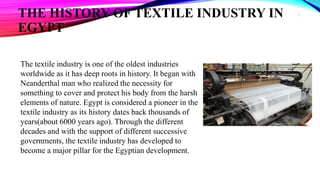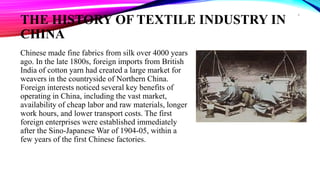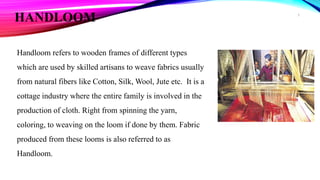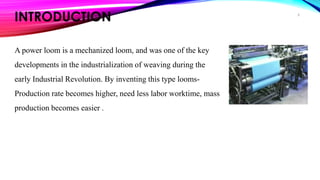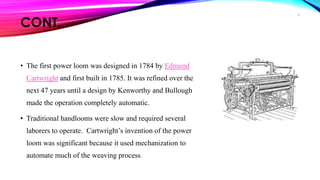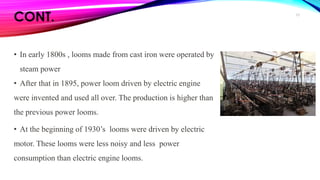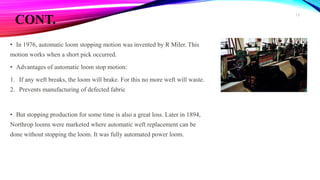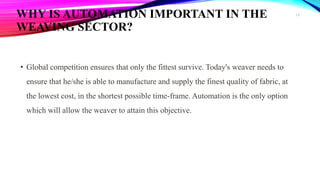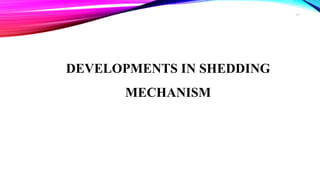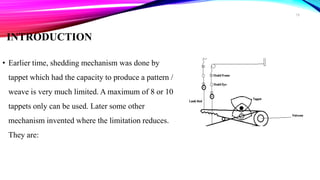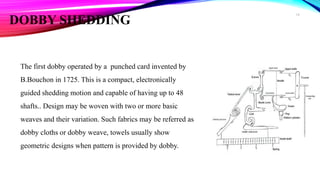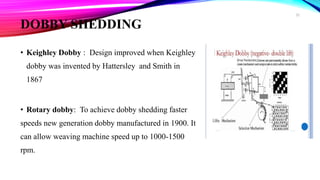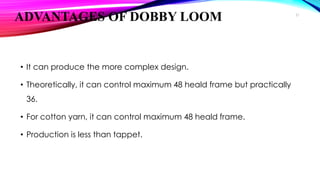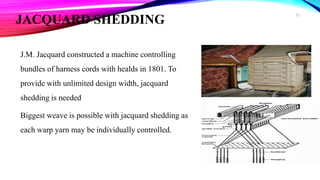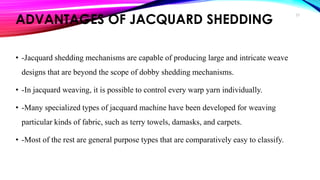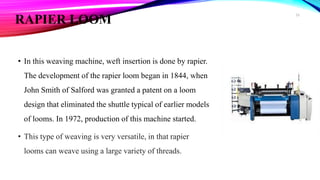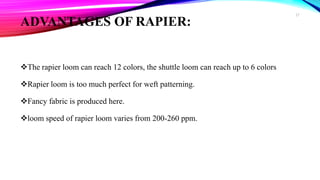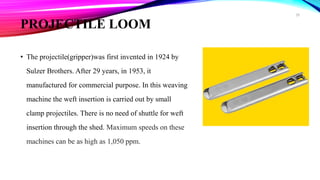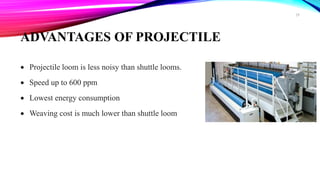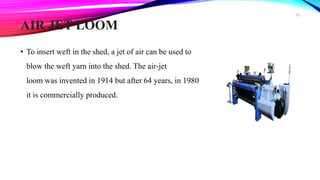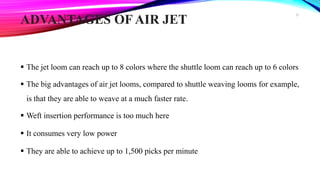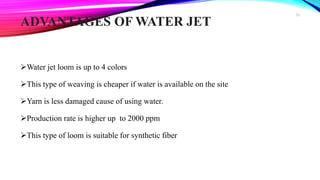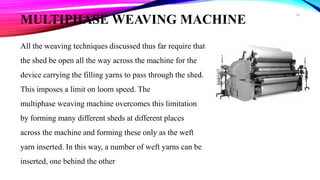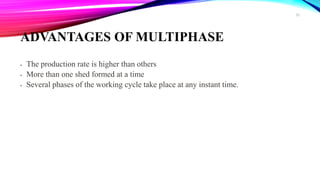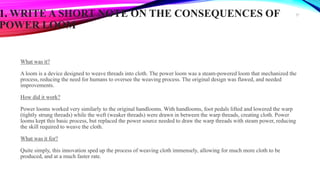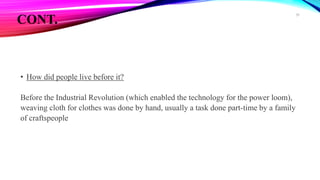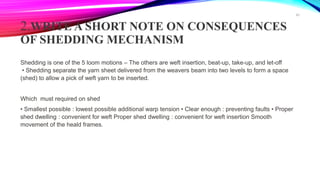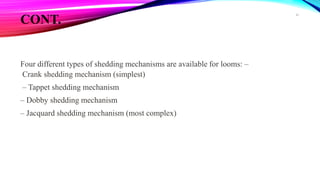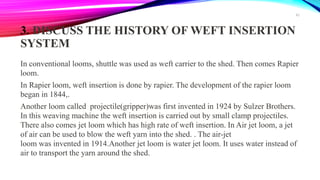Chronological development of loom .pdf
- 1. WELCOME TO OUR PRESENTATION Presentation on: Chronological developments of loom Prepared By: Md. Anarul Islam Imam Hossain Id:175042 Id:175054 Md. Sahab Uddin Md. Mosaddekjaman Id:175048 Id:175056 Md. Imran Hossain Md. Shamim Hossain Id:175050 Id:175059 1
- 3. THE HISTORY OF TEXTILE INDUSTRY IN EGYPT The textile industry is one of the oldest industries worldwide as it has deep roots in history. It began with Neanderthal man who realized the necessity for something to cover and protect his body from the harsh elements of nature. Egypt is considered a pioneer in the textile industry as its history dates back thousands of years(about 6000 years ago). Through the different decades and with the support of different successive governments, the textile industry has developed to become a major pillar for the Egyptian development. 3
- 4. THE HISTORY OF TEXTILE INDUSTRY IN CHINA Chinese made fine fabrics from silk over 4000 years ago. In the late 1800s, foreign imports from British India of cotton yarn had created a large market for weavers in the countryside of Northern China. Foreign interests noticed several key benefits of operating in China, including the vast market, availability of cheap labor and raw materials, longer work hours, and lower transport costs. The first foreign enterprises were established immediately after the Sino-Japanese War of 1904-05, within a few years of the first Chinese factories. 4
- 5. HANDLOOM Handloom refers to wooden frames of different types which are used by skilled artisans to weave fabrics usually from natural fibers like Cotton, Silk, Wool, Jute etc. It is a cottage industry where the entire family is involved in the production of cloth. Right from spinning the yarn, coloring, to weaving on the loom if done by them. Fabric produced from these looms is also referred to as Handloom. 5
- 6. HISTORY OF HANDLOOM 1. In 12th century, completely wooden hand looms were used as standard designs in England. 2. The developments in the design and performance of looms have taken place during the past 850 years. 3. The fly shuttle, invented in 1733 by John Kay, was hand operated. 4. It was an important cornerstone to improve the productivity. 5. This shuttle, running on four wheels, was moving over the lower side of the warp sheet. 6. Two wooden tenders connected to a small cord commanded by the hand were used to propel the shuttle. The weaver sitting in the middle of the loom threw the shuttle by pulling the cord very easily. 6
- 7. DEVELOPMENTS IN POWER LOOM 7
- 8. INTRODUCTION A power loom is a mechanized loom, and was one of the key developments in the industrialization of weaving during the early Industrial Revolution. By inventing this type looms- Production rate becomes higher, need less labor worktime, mass production becomes easier . 8
- 9. CONT. ŌĆó The first power loom was designed in 1784 by Edmund Cartwright and first built in 1785. It was refined over the next 47 years until a design by Kenworthy and Bullough made the operation completely automatic. ŌĆó Traditional handlooms were slow and required several laborers to operate. CartwrightŌĆÖs invention of the power loom was significant because it used mechanization to automate much of the weaving process. 9
- 10. CONT. ŌĆó In early 1800s , looms made from cast iron were operated by steam power ŌĆó After that in 1895, power loom driven by electric engine were invented and used all over. The production is higher than the previous power looms. ŌĆó At the beginning of 1930ŌĆÖs looms were driven by electric motor. These looms were less noisy and less power consumption than electric engine looms. 10
- 11. DEVELOPMENTS IN WEFT STOP MOTION 11
- 12. INTRODUCTION Many problem arises when production runs. So there need to stop loom for solving these problems. But if a loom runs without knowing it, it can cause a great loss. For this, automatic stop motion needs to apply on loom, so that it can identify the defect, it stop the loom. 12
- 13. CONT. ŌĆó In 1976, automatic loom stopping motion was invented by R Miler. This motion works when a short pick occurred. ŌĆó Advantages of automatic loom stop motion: 1. If any weft breaks, the loom will brake. For this no more weft will waste. 2. Prevents manufacturing of defected fabric ŌĆó But stopping production for some time is also a great loss. Later in 1894, Northrop looms were marketed where automatic weft replacement can be done without stopping the loom. It was fully automated power loom. 13
- 14. NEW TECHNOLOGY Now some modern weft stop motion invented. They are: ŌĆó Piezoelectric electronic weft stop: In the case of rapier and projectile weaving machine the mostly used device is provided with piezoelectric crystals. ŌĆó The optical sensors: In the case of fluid Jet machines, it is preferable not to hinder the weft fly, therefore optical sensors are used which do not touch the weft. 14
- 15. CONT. ŌĆó Automation has resulted in control of machines electronically from user friendly interfaces, produce intricate jacquard fabrics at the speed of commodity fabrics, inspect fabrics on loom, use optical and laser detection of warp break, reduce downtime due to higher levels of automation and quick style and warp beam change. The machine speed upto 1000 rpm is possible, 5 to 10 times faster than 20 years ago. 15
- 16. WHY IS AUTOMATION IMPORTANT IN THE WEAVING SECTOR? ŌĆó Global competition ensures that only the fittest survive. Today's weaver needs to ensure that he/she is able to manufacture and supply the finest quality of fabric, at the lowest cost, in the shortest possible time-frame. Automation is the only option which will allow the weaver to attain this objective. 16
- 18. INTRODUCTION ŌĆó Earlier time, shedding mechanism was done by tappet which had the capacity to produce a pattern / weave is very much limited. A maximum of 8 or 10 tappets only can be used. Later some other mechanism invented where the limitation reduces. They are: 18
- 19. DOBBY SHEDDING The first dobby operated by a punched card invented by B.Bouchon in 1725. This is a compact, electronically guided shedding motion and capable of having up to 48 shafts.. Design may be woven with two or more basic weaves and their variation. Such fabrics may be referred as dobby cloths or dobby weave, towels usually show geometric designs when pattern is provided by dobby. 19
- 20. DOBBY SHEDDING ŌĆó Keighley Dobby : Design improved when Keighley dobby was invented by Hattersley and Smith in 1867 ŌĆó Rotary dobby: To achieve dobby shedding faster speeds new generation dobby manufactured in 1900. It can allow weaving machine speed up to 1000-1500 rpm. 20
- 21. ADVANTAGES OF DOBBY LOOM ŌĆó It can produce the more complex design. ŌĆó Theoretically, it can control maximum 48 heald frame but practically 36. ŌĆó For cotton yarn, it can control maximum 48 heald frame. ŌĆó Production is less than tappet. 21
- 22. JACQUARD SHEDDING J.M. Jacquard constructed a machine controlling bundles of harness cords with healds in 1801. To provide with unlimited design width, jacquard shedding is needed Biggest weave is possible with jacquard shedding as each warp yarn may be individually controlled. 22
- 23. ADVANTAGES OF JACQUARD SHEDDING ŌĆó -Jacquard shedding mechanisms are capable of producing large and intricate weave designs that are beyond the scope of dobby shedding mechanisms. ŌĆó -In jacquard weaving, it is possible to control every warp yarn individually. ŌĆó -Many specialized types of jacquard machine have been developed for weaving particular kinds of fabric, such as terry towels, damasks, and carpets. ŌĆó -Most of the rest are general purpose types that are comparatively easy to classify. 23
- 24. DEVELOPMENTS IN WEFT INSERTION SYSTEM 24
- 25. INTRODUCTION: Weft insertion system is one of the major part in a loomŌĆÖs process. The production rate, capability, efficiency depends upon it. In the past, weft insertion was done by hand, after that flying shuttle uses in looms in 1733 by Jhon Kay, which makes the insertion of weft into the shed easier. Later weaving industry turns in a new path by improving the weft insertion system. These make revolutionary change in weaving industry. They newly weft insertion systems implement in: 25
- 26. RAPIER LOOM ŌĆó In this weaving machine, weft insertion is done by rapier. The development of the rapier loom began in 1844, when John Smith of Salford was granted a patent on a loom design that eliminated the shuttle typical of earlier models of looms. In 1972, production of this machine started. ŌĆó This type of weaving is very versatile, in that rapier looms can weave using a large variety of threads. 26
- 27. ADVANTAGES OF RAPIER: ’üČThe rapier loom can reach 12 colors, the shuttle loom can reach up to 6 colors ’üČRapier loom is too much perfect for weft patterning. ’üČFancy fabric is produced here. ’üČloom speed of rapier loom varies from 200-260 ppm. 27
- 28. PROJECTILE LOOM ŌĆó The projectile(gripper)was first invented in 1924 by Sulzer Brothers. After 29 years, in 1953, it manufactured for commercial purpose. In this weaving machine the weft insertion is carried out by small clamp projectiles. There is no need of shuttle for weft insertion through the shed. Maximum speeds on these machines can be as high as 1,050 ppm. 28
- 29. ADVANTAGES OF PROJECTILE ’éĘ Projectile loom is less noisy than shuttle looms. ’éĘ Speed up to 600 ppm ’éĘ Lowest energy consumption ’éĘ Weaving cost is much lower than shuttle loom 29
- 30. AIR JET LOOM ŌĆó To insert weft in the shed, a jet of air can be used to blow the weft yarn into the shed. The air-jet loom was invented in 1914 but after 64 years, in 1980 it is commercially produced. 30
- 31. ADVANTAGES OF AIR JET ’é¦ The jet loom can reach up to 8 colors where the shuttle loom can reach up to 6 colors ’é¦ The big advantages of air jet looms, compared to shuttle weaving looms for example, is that they are able to weave at a much faster rate. ’é¦ Weft insertion performance is too much here ’é¦ It consumes very low power ’é¦ They are able to achieve up to 1,500 picks per minute 31
- 32. WATER JET LOOM: A water jet loom is similar to an air jet loom but uses water instead of air to transport the yarn around the shed. Water jet looms can weave very quickly whilst the yarn is not damaged as water is less abrasive than solid matter moving the yarn around Water-jet looms use the same principle as air-jet looms, but they take advantage of pressurized water to propel the weft.. Picks per minute can reach as high as 1,000 32
- 33. ADVANTAGES OF WATER JET ’āśWater jet loom is up to 4 colors ’āśThis type of weaving is cheaper if water is available on the site ’āśYarn is less damaged cause of using water. ’āśProduction rate is higher up to 2000 ppm ’āśThis type of loom is suitable for synthetic fiber 33
- 34. MULTIPHASE WEAVING MACHINE All the weaving techniques discussed thus far require that the shed be open all the way across the machine for the device carrying the filling yarns to pass through the shed. This imposes a limit on loom speed. The multiphase weaving machine overcomes this limitation by forming many different sheds at different places across the machine and forming these only as the weft yarn inserted. In this way, a number of weft yarns can be inserted, one behind the other 34
- 35. ADVANTAGES OF MULTIPHASE ŌĆó The production rate is higher than others ŌĆó More than one shed formed at a time ŌĆó Several phases of the working cycle take place at any instant time. 35
- 37. 1. WRITE A SHORT NOTE ON THE CONSEQUENCES OF POWER LOOM What was it? A loom is a device designed to weave threads into cloth. The power loom was a steam-powered loom that mechanized the process, reducing the need for humans to oversee the weaving process. The original design was flawed, and needed improvements. How did it work? Power looms worked very similarly to the original handlooms. With handlooms, foot pedals lifted and lowered the warp (tightly strung threads) while the weft (weaker threads) were drawn in between the warp threads, creating cloth. Power looms kept this basic process, but replaced the power source needed to draw the warp threads with steam power, reducing the skill required to weave the cloth. What was it for? Quite simply, this innovation sped up the process of weaving cloth immensely, allowing for much more cloth to be produced, and at a much faster rate. 37
- 38. CONT. ŌĆó How did people live before it? Before the Industrial Revolution (which enabled the technology for the power loom), weaving cloth for clothes was done by hand, usually a task done part-time by a family of craftspeople. ŌĆó What was it for? Quite simply, this innovation sped up the process of weaving cloth immensely, allowing for much more cloth to be produced, and at a much faster rate. 38
- 39. CONT. ŌĆó How did people live before it? Before the Industrial Revolution (which enabled the technology for the power loom), weaving cloth for clothes was done by hand, usually a task done part-time by a family of craftspeople 39
- 40. 2.WRITE A SHORT NOTE ON CONSEQUENCES OF SHEDDING MECHANISM Shedding is one of the 5 loom motions ŌĆō The others are weft insertion, beat-up, take-up, and let-off ŌĆó Shedding separate the yarn sheet delivered from the weavers beam into two levels to form a space (shed) to allow a pick of weft yarn to be inserted. Which must required on shed ŌĆó Smallest possible : lowest possible additional warp tension ŌĆó Clear enough : preventing faults ŌĆó Proper shed dwelling : convenient for weft Proper shed dwelling : convenient for weft insertion Smooth movement of the heald frames. 40
- 41. CONT. Four different types of shedding mechanisms are available for looms: ŌĆō Crank shedding mechanism (simplest) ŌĆō Tappet shedding mechanism ŌĆō Dobby shedding mechanism ŌĆō Jacquard shedding mechanism (most complex) 41
- 42. 3. DISCUSS THE HISTORY OF WEFT INSERTION SYSTEM In conventional looms, shuttle was used as weft carrier to the shed. Then comes Rapier loom. In Rapier loom, weft insertion is done by rapier. The development of the rapier loom began in 1844,. Another loom called projectile(gripper)was first invented in 1924 by Sulzer Brothers. In this weaving machine the weft insertion is carried out by small clamp projectiles. There also comes jet loom which has high rate of weft insertion. In Air jet loom, a jet of air can be used to blow the weft yarn into the shed. . The air-jet loom was invented in 1914.Another jet loom is water jet loom. It uses water instead of air to transport the yarn around the shed. 42
- 43. THANK YOU FOR YOUR ATTENTION HAVE YOU ANY QUESTION? 43


